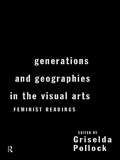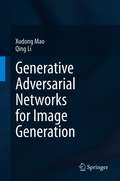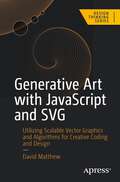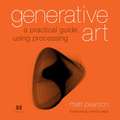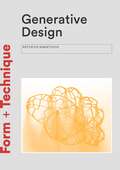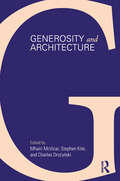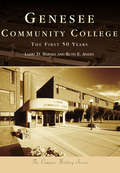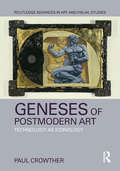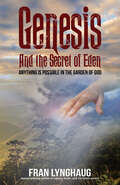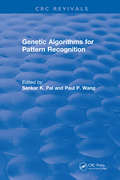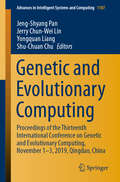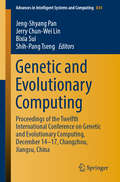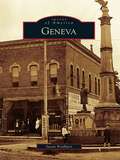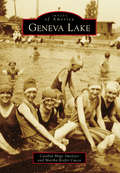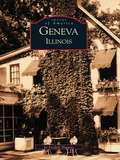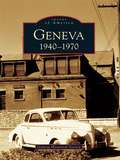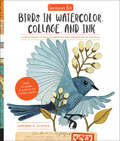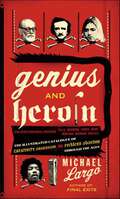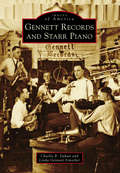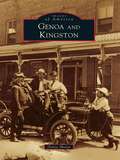- Table View
- List View
Generations and Geographies in the Visual Arts: Feminist Readings
by Griselda PollockIn Generations and Geographies in the Visual Achallenge of Arts: Feminist Readings the challenge of contemporary feminist theory encounters the provocation of the visual arts made by women in the twentieth century. The major issue is difference: sexual, cultural and social. The book points to the singularity of each artist's creative negotiation of time and historical and political circumstance. Griselda Pollock calls attention to the significance of place, location and cultural diversity, connecting issues of sexuality to those of nationality, imperialism, migration, diaspora and genocide.
Generations of Jewish Directors and the Struggle for America’s Soul: Wyler, Lumet, and Spielberg (Renewing the American Narrative)
by Sam B. GirgusFrom generation to generation, three outstanding American Jewish directors—William Wyler, Sidney Lumet, and Steven Spielberg--advance a tradition of Jewish writers, artists, and leaders who propagate the ethical basis of the American Idea and Creed. They strive to renew the American spirit by insisting that America must live up to its values and ideals. These directors accentuate the ethical responsibility for the other as a basis of the American soul and a source for strengthening American liberal democracy. In the manner of the jeremiad, their films challenge America to achieve a liberal democratic culture for all people by becoming more inclusive and by modernizing the American Idea. Following an introduction that relates aspects of modern ethical thought to the search for America’s soul, the book divides into three sections. The Wyler section focuses on the director’s social vision of a changing America. The Lumet section views his films as dramatizing Lumet’s dynamic and aggressive social and ethical conscience. The Spielberg section tracks his films as a movement toward American redemption and renewal that aspires to realize Lincoln’s vision of America as the hope of the world. The directors, among many others, perpetuate a “New Covenant” that advocates change and renewal in the American experience.
Generations of Somerset Place: From Slavery to Freedom (Images of America)
by Dorothy Spruill RedfordWhen the institution of slavery ended in 1865, Somerset Place was the third largest plantation in North Carolina. Located in the rural northeastern part of the state, Somerset was cumulatively home to more than 800 enslaved blacks and four generations of a planter family. During the 80 years that Somerset was an active plantation, hundreds of acres were farmed for rice, corn, oats, wheat, peas, beans, and flax. Today, Somerset Place is preserved as a state historic site offering a realistic view of what it was like for the slaves and freemen who once lived and worked on the plantation, once one of the Upper South's most prosperous enterprises.
Generative Adversarial Networks for Image Generation
by Qing Li Xudong MaoGenerative adversarial networks (GANs) were introduced by Ian Goodfellow and his co-authors including Yoshua Bengio in 2014, and were to referred by Yann Lecun (Facebook’s AI research director) as “the most interesting idea in the last 10 years in ML.” GANs’ potential is huge, because they can learn to mimic any distribution of data, which means they can be taught to create worlds similar to our own in any domain: images, music, speech, prose. They are robot artists in a sense, and their output is remarkable – poignant even. In 2018, Christie’s sold a portrait that had been generated by a GAN for $432,000. Although image generation has been challenging, GAN image generation has proved to be very successful and impressive. However, there are two remaining challenges for GAN image generation: the quality of the generated image and the training stability. This book first provides an overview of GANs, and then discusses the task of image generation and the details of GAN image generation. It also investigates a number of approaches to address the two remaining challenges for GAN image generation. Additionally, it explores three promising applications of GANs, including image-to-image translation, unsupervised domain adaptation and GANs for security. This book appeals to students and researchers who are interested in GANs, image generation and general machine learning and computer vision.
Generative Art with JavaScript and SVG: Utilizing Scalable Vector Graphics and Algorithms for Creative Coding and Design (Design Thinking)
by David MatthewThis book introduces you to the exciting world of generative art and creative coding through the medium of JavaScript and Scalable Vector Graphics (SVG). Using tried and trusted techniques, you’ll tackle core topics such as randomness and regularity, noise and naturalistic variance, shape and path creation, filter effects, animation, and interactivity. In the process you’ll learn SvJs, a JavaScript library that closely mirrors the SVG spec and makes scripting SVG intuitive and enjoyable. You’ll also study the craft of generative art and its creative process, along with JavaScript fundamentals, using modern ES6+ syntax. Each chapter will build upon the previous one, and those completely new to programming will be given a primer to help them find their feet. Generative Art with JavaScript and SVG will take you on a fun journey, peppered with plenty of sketches throughout, designed not only to explain, but to inspire. You Will: • Structure and randomise compositions. • Understand the different types of randomness and their probability distributions. • Create organic variance with the SvJs Noise module. • Apply SVG filter effects in a generative fashion. • Explore different approaches to animating with SVG. • Make your compositions dynamic and interactive. WHO IS IT FOR: Web developers and designers and creative coders with an interest in digital and generative art as well as artists who are interested in learning to code with JavaScript.
Generative Art: A practical guide using Processing
by Matt PearsonSummaryGenerative Art presents both the technique and the beauty of algorithmic art. The book includes high-quality examples of generative art, along with the specific programmatic steps author and artist Matt Pearson followed to create each unique piece using the Processing programming language.About the TechnologyArtists have always explored new media, and computer-based artists are no exception. Generative art, a technique where the artist creates print or onscreen images by using computer algorithms, finds the artistic intersection of programming, computer graphics, and individual expression. The book includes a tutorial on Processing, an open source programming language and environment for people who want to create images, animations, and interactions.About the BookGenerative Art presents both the techniques and the beauty of algorithmic art. In it, you'll find dozens of high-quality examples of generative art, along with the specific steps the author followed to create each unique piece using the Processing programming language. The book includes concise tutorials for each of the technical components required to create the book's images, and it offers countless suggestions for how you can combine and reuse the various techniques to create your own works. Purchase of the print book comes with an offer of a free PDF, ePub, and Kindle eBook from Manning. Also available is all code from the book. What's InsideThe principles of algorithmic artA Processing language tutorialUsing organic, pseudo-random, emergent, and fractal processes=================================================Table of ContentsPart 1 Creative CodingGenerative Art: In Theory and PracticeProcessing: A Programming Language for ArtistsPart 2 Randomness and NoiseThe Wrong Way to Draw A LineThe Wrong Way to Draw a CircleAdding DimensionsPart 3 ComplexityEmergenceAutonomyFractals
Generative Design
by Asterios AgkathidisGenerating form is one of the most fundamental aspects of architectural education and practice. While new computational tools are enabling ever more unpredictable forms, critics argue that this leads to a disconnection between architectural output and its context.This attractive, pocket-sized book uses 11 different architectural projects to explore how generative design processes can integrate digital as well as physical design tools and techniques to produce innovative forms that cohere with structural and material principles, performance and context.Illustrated with drawings, computer images and models, this stimulating, accessible handbook of ideas provides a guide for students as well as an inspiration for practising architects.
Generative Design (Form + Technique)
by Asterios AgkathidisGenerating form is one of the most fundamental aspects of architectural education and practice. While new computational tools are enabling ever more unpredictable forms, critics argue that this leads to a disconnection between architectural output and its context.This attractive, pocket-sized book uses 11 different architectural projects to explore how generative design processes can integrate digital as well as physical design tools and techniques to produce innovative forms that cohere with structural and material principles, performance and context.Illustrated with drawings, computer images and models, this stimulating, accessible handbook of ideas provides a guide for students as well as an inspiration for practising architects.
Generosity and Architecture
by Mhairi McVicar, Stephen Kite, and Charles DrożyńskiThis book proposes that architecture can function as a true embodiment of generosity and examines how generosity in architecture operates within, and questions, current and historical socio-economic and political systems. As such, it interrogates ways in which architecture aspires for something more, whether within economic austerities or within historic contexts of a discipline that has often been preoccupied with cost and quantitative measurement. The texts presented in this book critically examine the theme of generosity and architecture from a variety of perspectives, addressing the theoretical, the historical, and the everyday processes of architectural practice, procurement, and policy in a global context. The book is a richly collaborative text which explores how architecture – in its processes of ordering and shaping space – can represent and embody generosity in all its multi-faceted potential.
Genesee Community College: The First 50 Years (Campus History)
by Larry D. Barnes Ruth E. AndesFounded in 1966, Genesee Community College (GCC) is the product of a grassroots movement that culminated in a public referendum supporting the creation of a community college. The resulting institution has exceeded the most optimistic predictions of its early proponents. From its beginning in a converted department store with 367 students, GCC, part of the State University of New York, has grown to over 7,000 students studying in more than 60 different programs. The college is spread over four rural counties in Western New York. The main campus in Batavia and six satellite sites, plus distance learning opportunities, serve citizens living within a 2,400-square-mile service area. The GCC student body also includes students from elsewhere in New York State, out of state, and several other nations. Currently, there are over 150 international students. Committed to the dual goals of ready access and student success, the 50-year history of GCC is a story of dynamic achievement through innovative programs, workforce development, and community involvement.
Genesee County: 1900-1960
by Genesee County Historical SocietyMost postcards were written as quick messages to let a friend or family know that "I arrived OK" or someone was "thinking of you." Now the vintage cards in this book are carrying another message, giving readers a glimpse of what small-town life was like early in the 20th century, when the majority of these cards were produced. During the first half of the 20th century in Genesee County, the communities outside of Flint were small, but visitors and residents still wanted postcards depicting scenes from Davison, Fenton, Flushing, Grand Blanc, and even the smaller settlements such as Otterburn and Atlas. Railroad stations, churches, and town halls were common subjects, but some surprises were found too in the search for postcard images of Genesee County.
Geneses of Postmodern Art: Technology As Iconology (Routledge Advances in Art and Visual Studies)
by Paul CrowtherPostmodernism in the visual arts is not just another 'ism.' It emerged in the 1960s as a transformation of artistic creativity inspired by Duchamp's idea that the artwork does not have to be physically made by its creator. Products of mass culture and technology can be used just as well as traditional media. This idea became influential because of a widespread naturalization of technology - where technology becomes something lived in as well as used. Postmodern art embodies this attitude. To explain why, Paul Crowther investigates topics such as eclecticism, the sublime, deconstruction in art and philosophy, and Paolozzi's Wittgenstein-inspired works.
Genesis And the Secret of Eden: Anything is possible in the garden of God
by Fran LynghaugA cloudy fog rose abruptly out of the ground about fifty feet in front of them. A magnificently handsome figure in its midst gradually took shape. He didn't send his thoughts to them the same way Adam and Eve talked with their thoughts, but used spoken verbiage. “My greetings to you...” That was as far as he got. Raphael and Uriel drew their swords from sheaths that were hidden in a fold of their tunics, readying for a charge. They obviously knew this person and braced for battle. For the first time, Eve experienced confusion. She didn't know what it was like to flee. She just knew she had to leave quickly. She lifted into the sky and when she had attained a good height, she darted toward the palace. She was aware of someone at her side. It was Uriel. He didn't speak to her thoughts, but his expression was grim.
Genetic Algorithms for Pattern Recognition (CRC Press Revivals)
by Sankar K. Pal Paul P. WangSolving pattern recognition problems involves an enormous amount of computational effort. By applying genetic algorithms - a computational method based on the way chromosomes in DNA recombine - these problems are more efficiently and more accurately solved. Genetic Algorithms for Pattern Recognition covers a broad range of applications in science and technology, describing the integration of genetic algorithms in pattern recognition and machine learning problems to build intelligent recognition systems. The articles, written by leading experts from around the world, accomplish several objectives: they provide insight into the theory of genetic algorithms; they develop pattern recognition theory in light of genetic algorithms; and they illustrate applications in artificial neural networks and fuzzy logic. The cross-sectional view of current research presented in Genetic Algorithms for Pattern Recognition makes it a unique text, ideal for graduate students and researchers.
Genetic and Evolutionary Computing: Proceedings of the Thirteenth International Conference on Genetic and Evolutionary Computing, November 1–3, 2019, Qingdao, China (Advances in Intelligent Systems and Computing #1107)
by Jeng-Shyang Pan Shu-Chuan Chu Jerry Chun-Wei Lin Yongquan LiangThis book gathers papers presented at the 13th International Conference on Genetic and Evolutionary Computing (ICGEC 2019), which was held in Qingdao, China, from 1st to 3rd, November 2019. Since it was established, in 2006, the ICGEC conference series has been devoted to new approaches with a focus on evolutionary computing. Today, it is a forum for the researchers and professionals in all areas of computational intelligence including evolutionary computing, machine learning, soft computing, data mining, multimedia and signal processing, swarm intelligence and security. The book appeals to policymakers, academics, educators, researchers in pedagogy and learning theory, school teachers, and other professionals in the learning industry, and further and continuing education.
Genetic and Evolutionary Computing: Proceedings of the Twelfth International Conference on Genetic and Evolutionary Computing, December 14-17, Changzhou, Jiangsu, China (Advances in Intelligent Systems and Computing #834)
by Jeng-Shyang Pan Jerry Chun-Wei Lin Bixia Sui Shih-Pang TsengThis volume of Advances in Intelligent Systems and Computing highlights papers presented at the 12th International Conference on Genetic and Evolutionary Computing (ICGEC 2018). Held from 14 to 17 December 2018 in Changzhou, Jiangsu, China, the conference was co-sponsored by Springer, Changzhou College of Information Technology, Fujian Provincial Key Lab of Big Data Mining and Applications, Fujian University of Technology, National Demonstration Center for Experimental Electronic Information and Electrical Technology Education, Fujian University of Technology, Tajen University, National University of Kaohsiung, and Shandong University of Science and Technology, China. The conference is intended as an international forum for the researchers and professionals in all areas of genetic and evolutionary computing.
Geneva (Images of America)
by Susan BradburnThe area's first settlers, Theobalt Bartholomew and his family, left Charlotte, New York, and arrived on South Ridge Road near Cowles Creek in 1805. Geneva, however, was named by another early settler, Maj. Levi Gaylord, who suggested naming it after the small, beautiful town of Geneva, New York. By the mid-1800s, word traveled back to the East Coast of the fertile soil in Ohio, and soon many farmers came on horseback, in oxcarts, and on foot, driving herds of cattle to the area, and the population grew to about 150. The area along Lake Erie soon became a popular tourist destination with its grape-growing industry, Ohio's first resort, and fishing in the Grand River. The area prospered into a community united by work, recreation, and sport. This collection of historic images highlights the histories of Geneva, Geneva on the Lake, and Harpersfields from 1805 to the present day.
Geneva Lake
by Carolyn Hope Smeltzer Martha Kiefer CuccoGeneva Lake was formed by a glacier tens of thousands of years ago. The Oneota left historic footprints with a cultural gift in the form of the shore path, which is accessible for all to walk just as the natives did many centuries earlier. Images of America: Geneva Lake illustrates the early history of the communities surrounding the lake--Lake Geneva, Linn, Fontana, and Williams Bay--through scrapbooks, vintage photographs, and storytelling. The chapters in this book cover the history of people, places, pioneers, physical chores, and play at Geneva Lake. Families who have spent time at the lake for generations share enchanting memories, and those new to it can experience "lake living years ago."
Geneva, Illinois (Images of America)
by Jo Fredell HigginsThe essence of Geneva lies in the city's distinctive hometown quality and relaxed atmosphere. Visitors sense a slower pace and tender ambience that flourished even before Geneva was platted on May 3, 1837. Geneva, Illinois presents a remarkable portrait of the community's earliest beginnings and present-day charms. Geneva offers the vintage flavor of an historic city as well as the contemporary feel of a modern community. In this collection you will find early portraits of education, when lessons were taught in the dining room of a local hotel, along with scenes that celebrate the lush riverbanks upon which residents and guests have enjoyed picnics for more than a hundred years. From the flowers picked at Wheeler Park to the moving pictures of the Optigraph, from the wooden ice cabinets of 1884 to the sidewalk cafes of today, Geneva has flourished.
Geneva: 1940-1970
by Geneva Historical SocietyLike many American towns, Geneva changed dramatically in the mid-20th century. Geneva: 1940-1970 examines events that influenced the city, among them the influx of sailors and workers at the nearby Sampson Naval Training Station during World War II and the construction of the Routes 5 and 20 bypass in the 1950s. Many factories ceased operation during this time, and downtown businesses began feeling pressure from a new shopping plaza and stores on the edge of town. The book also captures the social life of the community and notable people who visited Geneva, such as Bobby Kennedy and Jane Russell, and those who grew up here, such as legendary jazz bassist Scott LaFaro.
Geneva: 1940-1970 (Images of America)
by Geneva Historical SocietyGeneva lies in the heart of the Finger Lakes region at the top of Seneca Lake, which is important to the community for both transportation and leisure. With more than two hundred vintage images, Geneva presents a well-researched overview of the town's past, from its settlement in the 1790s to 1940. Pictured are some of the architectural gems that became the cultural cornerstones of a thriving place-the Smith Opera House, the Richard Upjohn-designed Blackwell House and St. John's Chapel on the Hobart & William Smith campus, as well as some of the remarkable people who lived here: Dr. Elizabeth Blackwell, the first woman in the country to receive a medical degree; Henry McDonald, one of the first African American professional football players; Arthur Dove, America's first modernist painter; and Joseph Swift, the first graduate of West Point.
Geninne's Art: Birds In Watercolor, Collage, and Ink
by Geninne ZlatkisA personal field guide to how the popular Santa Fe artist finds her inspiration and creates her charming paintings and collages of birds and nature.Brimming with inspiring examples of the artist’s work, this beautiful book takes you inside Geninne’s studio for an in-depth look at how she creates. You will discover, step by step, how this devoted artist spends time photographing nature, selecting her materials, and developing her personal imagery. Explore:How her studio is set up, how she works, and what materials and tools she usesHow she captures nature with both a camera and phone for referenceHer artistic process through the step-by-step creation of 5 watercolor paintings, 5 collages, and 5 ink drawings, with notes on each medium and techniqueAs a special bonus, the book includes 32 pages of collage papers, painted and selected by Geninne, for you to use as you explore and develop your own artistic voice.Vibrant, detailed, and richly imaginative, Geninne’s interpretation of the birds she has observed so closely will inspire you to use the natural world as fodder for your paintings, drawings, and collages.“Lovely . . . If you’re a playful artist avid about collage or ink drawing, you might be smitten.” —Arts & Activities
Genius and Heroin: Creativity, Obsession and Reckless Abandon Through the Ages
by Michael LargoWhat is the price of brilliance?Why are so many creative geniuses also ruinously self-destructive? From Caravaggio to Jackson Pollack, from Arthur Rimbaud to Jack Kerouac, from Charlie Parker to Janis Joplin, to Kurt Cobain, and on and on, authors and artists throughout history have binged, pill-popped, injected, or poisoned themselves for their art. Fully illustrated and addictively readable, Genius and Heroin is the indispensable reference to the untidy lives of our greatest artists and thinkers, entertainingly chronicling how the notoriously creative lived and died—whether their ultimate downfalls were the result of opiates, alcohol, pot, absinthe, or the slow-motion suicide of obsession.
Gennett Records and Starr Piano (Images of America)
by Charlie B. Dahan Linda Gennett IrmscherThe Starr Piano Company, based in Richmond, Indiana, quickly became one of the largest piano manufacturers in the United States during the 19th century. In 1915, the Starr Piano Company opened a recording division, Gennett Records, that led to a dynamic change in the music industry and American culture. Gennett embraced the vastly under-recorded genres of jazz, blues, and country music in the 1920s. They recorded artists who were groundbreakers and innovators in both popular and vernacular music, including Louis Armstrong, Charley Patton, Gene Autry, Hoagy Carmichael, Blind Lemon Jefferson, Uncle Dave Macon, and Jelly Roll Morton, often for the first time. The company, like many others, suffered a steep decline in the sale of their pianos and records due to the Great Depression, but the music recorded at Gennett continues to reach new generations and influence musicians as they discover it on reissues and streaming media services.
Genoa and Kingston
by Denise MoranIn 1835, while Charles Darwin aboard the HMS Beagle was exploring the Galapagos Islands, the northern Illinois municipalities of Genoa and Kingston were being settled. Pioneers arrived via the historic Chicago-Galena stagecoach trail. Thomas Matteson, a Revolutionary War soldier from Ohio, and his family traveled in three covered wagons and became Genoa's first settlers. Genoa was incorporated as a village in 1876 and as a city in 1911. Kingston became a village in 1886. In addition to sharing a boundary, the municipalities share the Genoa-Kingston Fire Department, Genoa-Kingston Middle School, and Genoa-Kingston High School. During the Civil War, 109 men from Genoa and 105 men from Kingston, roughly a tenth of the population of each municipality at that time, enlisted in the Union Army. Men and women from Genoa and Kingston have continued to serve in the U.S. military from World Wars I and II to the wars in Iraq and Afghanistan.
